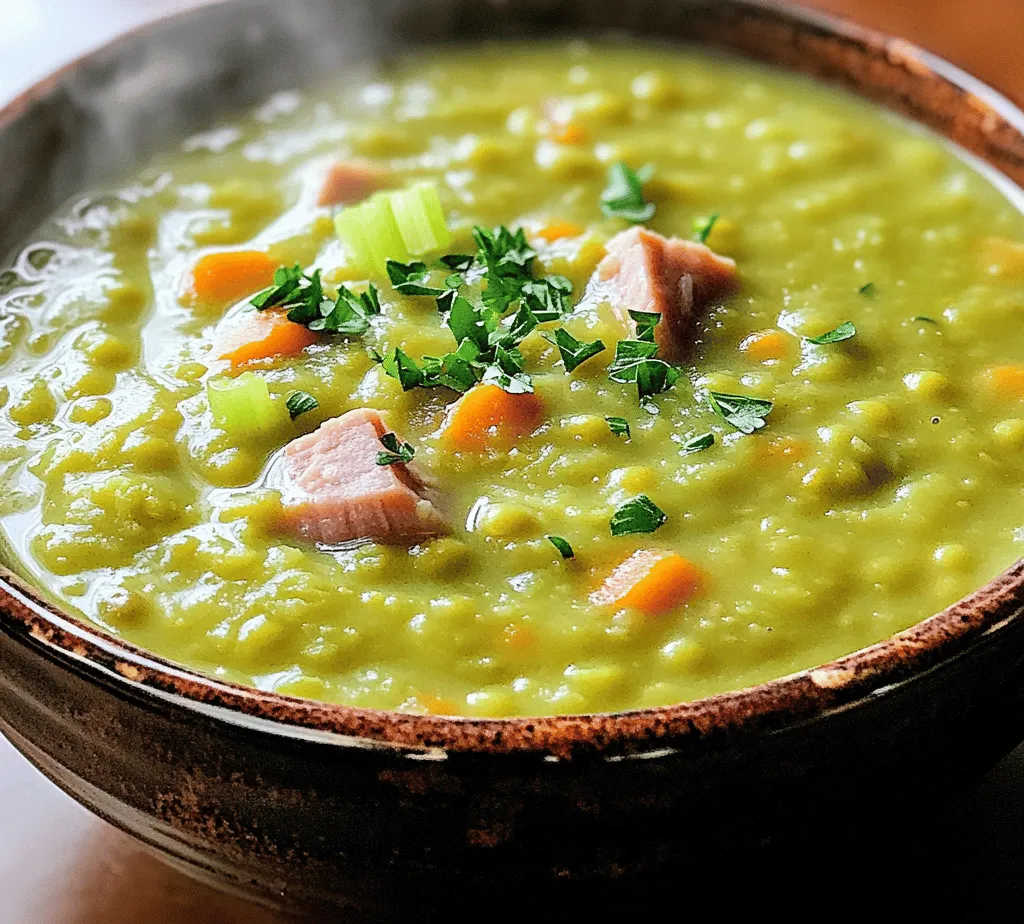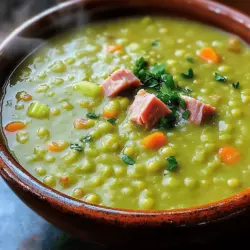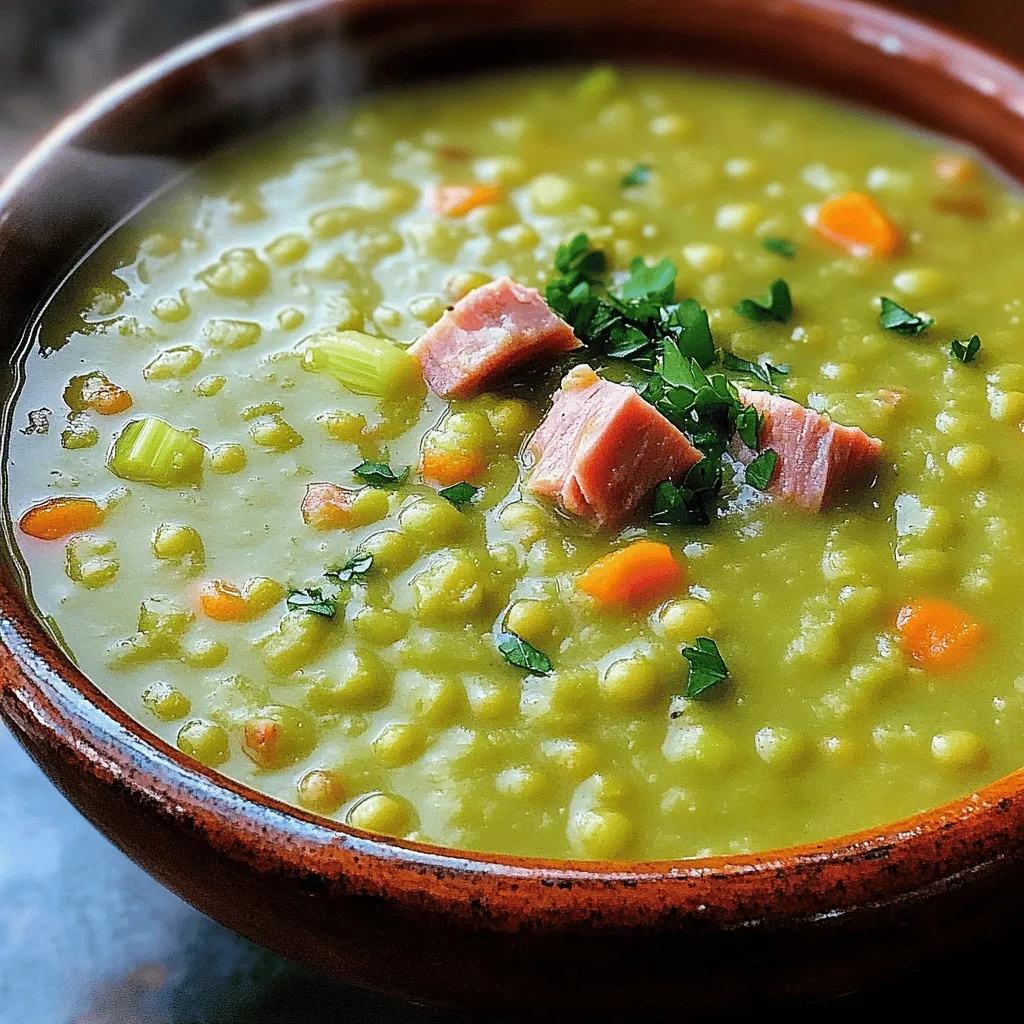Introduction to Rustic Split Pea and Ham Soup
As the temperature drops and the days grow shorter, the allure of a steaming bowl of soup becomes irresistible. One dish that perfectly embodies the essence of comfort food is Rustic Split Pea and Ham Soup. This hearty soup, rich in flavor and nutrients, has been a staple in many households, especially during the colder months. The combination of tender split peas and savory diced ham creates a satisfying meal that warms both body and soul.
Split pea soup has garnered a reputation for its ability to nourish and satisfy. Not only does it offer a delightful blend of flavors, but it is also packed with nutritional benefits. Split peas are an excellent source of plant-based protein, fiber, and essential vitamins and minerals. When combined with the smoky, savory notes of ham, this soup becomes a wholesome dish that is both filling and nutritious.
Moreover, the appeal of homemade soups resonates deeply with many, particularly for meal prep enthusiasts. Cooking a large batch of Rustic Split Pea and Ham Soup not only provides an easy, healthy meal option throughout the week but also fills the home with inviting aromas, evoking a sense of comfort and warmth.
The Origins of Split Pea Soup
The history of split pea soup dates back centuries, with roots traced to various cultures around the globe. Ancient Greeks and Romans enjoyed a form of pea soup, and as the years progressed, different regions adapted the dish to their local ingredients and tastes. In Europe, particularly in countries like France and the Netherlands, split pea soup became a beloved staple, often associated with rustic, hearty fare.
In France, the traditional “soupe au pois” is a famous version made with green split peas and sometimes includes ham or bacon to enhance the flavor. Meanwhile, in the Netherlands, the dish takes on a slightly thicker consistency, often served with a side of rye bread. Each culture contributes its unique spin, showcasing the versatility of split peas as a primary ingredient.
Historically, split peas have played a significant role in nutritional diets, particularly in times of scarcity. The dried peas are shelf-stable and provide essential nutrients, making them a reliable food source for those in need. Their high fiber content promotes digestive health, while their protein-packed profile supports muscle maintenance and overall well-being.
Understanding the Ingredients
To create a truly exceptional Rustic Split Pea and Ham Soup, it’s crucial to understand the role of each ingredient in the recipe. Here’s a breakdown of what you’ll need:
Dried Split Peas
At the heart of this soup are dried split peas, which come in two primary varieties: green and yellow. Both types are nutritionally dense, offering high levels of protein, fiber, and essential vitamins like folate and iron. When selecting dried split peas, look for a vibrant color and avoid any that appear dull or have an off smell. Quality split peas will cook evenly and impart a rich flavor to your soup.
Olive Oil
Olive oil serves as the base for sautéing the vegetables, providing a healthy source of fat that enhances the overall flavor of the soup. Known for its heart-healthy properties, olive oil contains monounsaturated fats and antioxidants that can benefit cardiovascular health. Using high-quality extra virgin olive oil adds a depth of flavor that complements the other ingredients.
Vegetables
A robust soup starts with a flavorful base, and that’s where the vegetables come in. The classic combination of onion, garlic, carrots, and celery, often referred to as mirepoix, forms the aromatic foundation of the soup.
– Onion: Adds sweetness and depth.
– Garlic: Infuses the dish with a rich, fragrant aroma.
– Carrots: Provide natural sweetness and color.
– Celery: Contributes a subtle earthiness and crunch.
Chopping these vegetables uniformly ensures even cooking and a balanced flavor profile throughout the soup.
Herbs and Spices
Herbs and spices elevate the soup’s taste and aroma. Bay leaves and thyme are classic additions that impart warmth and complexity.
– Bay Leaf: Adds a subtle depth and aromatic quality, enhancing the overall flavor.
– Thyme: Brings an earthy, slightly minty flavor that complements the split peas and ham beautifully.
These ingredients not only enhance the flavor but also provide potential health benefits, such as anti-inflammatory properties and antioxidants.
Broth
The choice of broth significantly impacts the soup’s flavor. You can use either chicken or vegetable broth, depending on your dietary preferences.
– Chicken Broth: Offers a rich, savory flavor that pairs well with the smoky ham.
– Vegetable Broth: Provides a lighter option for those seeking a vegetarian alternative.
For the best results, consider making your own homemade broth. This allows you to control the sodium content and infuse the broth with your favorite herbs and spices.
Diced Ham
Choosing the right type of ham is crucial for achieving that signature smoky flavor in your soup. Smoked ham hocks or diced ham are popular choices for this recipe.
– Smoked Ham: Delivers a robust, smoky flavor that permeates the soup.
– Unsalted Diced Ham: Offers a milder flavor, allowing the other ingredients to shine.
When selecting ham, opt for high-quality, minimally processed options to ensure the best taste and health benefits.
Garnishes
Lastly, fresh parsley serves as a simple yet effective garnish, adding a pop of color and a burst of freshness to your Rustic Split Pea and Ham Soup. Its mild, earthy flavor complements the soup while also providing additional nutrients.
Step-by-Step Instructions for Making Rustic Split Pea and Ham Soup
Once you have all your ingredients ready, it’s time to dive into the cooking process. Follow these detailed instructions to create a delicious batch of Rustic Split Pea and Ham Soup.
Preparation of Ingredients
The initial step in making this hearty soup is to prepare your ingredients properly:
1. Rinse the Split Peas: Place the dried split peas in a fine-mesh strainer and rinse them under cold water. This removes any dust or debris and helps improve the soup’s clarity. After rinsing, set the peas aside to drain.
2. Chop the Vegetables: Begin by finely chopping the onion, garlic, carrots, and celery. Use a sharp knife and a cutting board for efficiency. Aim for uniform pieces to ensure even cooking. For the onion, remove the skin and cut off the ends before dicing. Mince the garlic cloves finely to release their aromatic oils.
3. Prepare the Ham: If you haven’t done so already, dice your smoked ham into bite-sized pieces. This allows for even distribution of flavor throughout the soup.
Cooking Process
With your ingredients prepared, follow these steps to cook your Rustic Split Pea and Ham Soup:
1. Heat the Olive Oil: In a large pot or Dutch oven, heat a couple of tablespoons of olive oil over medium heat. Allow the oil to warm before adding the vegetables.
2. Sauté the Aromatics: Add the chopped onion, garlic, carrots, and celery to the pot. Sauté the vegetables for about 5-7 minutes, stirring occasionally, until they are softened and fragrant. The onions should become translucent, and the garlic should be aromatic but not browned.
3. Incorporate the Split Peas: Once the vegetables are ready, add the rinsed split peas to the pot. Stir to combine them with the sautéed vegetables, allowing the peas to absorb some of the flavors.
4. Add the Broth: Pour in your choice of broth (chicken or vegetable) and bring the mixture to a boil. Ensure that the broth fully covers the peas and vegetables.
5. Introduce the Ham and Seasonings: Add the diced ham, bay leaf, and thyme to the pot. Season with salt and pepper to taste. Stir well to incorporate all the ingredients, then reduce the heat to a simmer.
6. Simmer the Soup: Cover the pot and let the soup simmer on low heat for about 45 minutes to 1 hour. During this time, the split peas will soften and break down, creating a creamy texture. Stir occasionally to prevent sticking and ensure even cooking.
As the soup simmers, the delightful aroma will fill your kitchen, inviting everyone to gather around for a warm, comforting meal.
Stay tuned for the next part, where we will explore more detailed cooking tips, variations, and frequently asked questions about this delightful dish!

Importance of Sautéing Onions and Garlic Properly for Flavor Development
Sautéing onions and garlic forms the foundational flavor of Rustic Split Pea and Ham Soup. Begin by heating a couple of tablespoons of oil or butter in a large pot over medium heat. Add the chopped onions and cook them until they become translucent, about 5-7 minutes. This process releases the natural sugars in the onions and enhances their sweetness, which is crucial for balancing the soup’s earthy flavors.
Once the onions are softened, add minced garlic and sauté for an additional 1-2 minutes. Garlic can burn quickly, leading to a bitter taste, so keep an eye on it. The aromatic combination of sautéed onions and garlic will infuse your soup with a depth of flavor that is hard to replicate.
Incorporating Vegetables and Understanding Cooking Times
After the onions and garlic are perfectly sautéed, it’s time to add your vegetables. Carrots and celery are traditional choices in split pea soup and contribute both flavor and nutrition. Dice the carrots and celery into small, even pieces to ensure they cook uniformly. Add them to the pot and continue to sauté for another 5 minutes until they soften slightly.
Understanding cooking times is essential in achieving the ideal texture for each vegetable. For instance, potatoes can be added at this stage if you desire a heartier soup. Potatoes generally take longer to cook, so they benefit from this initial sautéing. If you choose to add any quicker-cooking vegetables, such as spinach or kale, reserve them for the last few minutes of cooking to maintain their vibrant color and nutritional value.
The Crucial Steps of Adding Split Peas and Broth, and Adjusting Heat for Simmering
Once your vegetables are tender, it’s time to introduce the star of the dish: the split peas. Rinse the peas under cold water to remove any debris, then add them to the pot. Stir them in with the sautéed vegetables, allowing them to absorb the flavors for about a minute.
Next, pour in the broth. A good quality chicken or vegetable broth works best, as it adds richness to the soup. The general ratio is 1 cup of split peas to 4 cups of broth; adjust accordingly depending on how thick you prefer your soup. Bring the mixture to a boil, then reduce the heat to a low simmer. Cover the pot and allow it to cook for 30-45 minutes, stirring occasionally. This gentle simmer will help the split peas break down and thicken the soup while ensuring that all the flavors meld beautifully.
Blending Techniques for Different Textures and Preferences
After simmering, the split peas should be tender. At this point, you can decide on the texture of your soup. For a smoother consistency, use an immersion blender to puree the soup directly in the pot. Blend until you reach your desired creaminess, but leave some chunks for texture if you prefer a rustic feel.
Alternatively, transfer portions of the soup in batches to a countertop blender for a smoother finish. Make sure to let the soup cool slightly before blending to avoid steam buildup, which can lead to splattering. If you enjoy a chunkier soup, simply skip this blending step and serve the soup as is.
Final Incorporation of Ham and Seasoning for Optimal Taste
Now that your soup is at the desired texture, it’s time to add the ham. Dice your cooked ham and stir it into the soup. The heat will warm the ham through without overcooking it, preserving its smoky flavor.
Season your soup with salt and freshly ground black pepper to taste. Remember that the ham can be quite salty, so it’s best to taste before adding additional salt. You can also enhance the flavor by adding herbs such as thyme or bay leaves during the simmering phase. Fresh herbs can be added just before serving for a burst of freshness.
Nutritional Profile of Rustic Split Pea and Ham Soup
Rustic Split Pea and Ham Soup is not only comforting but also packed with nutritional benefits. Each serving is rich in protein, fiber, and essential vitamins.
Overview of the Health Benefits of Key Ingredients
– Split Peas: These legumes are an excellent source of plant-based protein and fiber, which aids digestion and helps maintain stable blood sugar levels.
– Vegetables: Carrots and celery add vitamins A and C, potassium, and fiber, contributing to overall health and wellness.
– Ham: Provides protein and essential nutrients like iron and zinc, which are important for immune function and muscle health.
Caloric Content and Macronutrient Breakdown Per Serving
On average, a one-cup serving of Rustic Split Pea and Ham Soup contains approximately 250-300 calories, depending on the amount of ham and oil used. The approximate macronutrient breakdown is as follows:
– Protein: 15-20 g
– Carbohydrates: 35-40 g
– Fat: 5-10 g
Discussion on Dietary Considerations for Various Audiences
This soup can easily cater to different dietary needs. It is naturally gluten-free, making it suitable for those with gluten sensitivities. Additionally, the high fiber content makes it a great option for those seeking to increase their fiber intake, supporting digestive health.
Variations and Customizations
Rustic Split Pea and Ham Soup can be tailored to suit various tastes and dietary preferences.
Exploring Different Types of Split Pea Soup (Green vs. Yellow Peas)
While green split peas are the more traditional choice, yellow split peas can also be used for a slightly sweeter soup. Both types offer similar nutritional benefits, but the flavor profile and color will differ. Experimenting with both can provide a delightful twist on this classic recipe.
Suggestions for Vegetarian or Vegan Adaptations
For a vegetarian or vegan version, simply omit the ham and use vegetable broth. To add depth of flavor, consider incorporating smoked paprika or liquid smoke for that smoky essence typically provided by ham. Adding mushrooms can also enhance the umami taste.
Incorporating Additional Vegetables or Spices for Personalized Flavor Profiles
Feel free to customize your soup by adding other vegetables such as bell peppers, zucchini, or even greens like kale or spinach. Spices such as cumin, coriander, or curry powder can introduce exciting flavor notes, creating a unique twist on the traditional recipe.
Ideas for Serving with Sides or Toppings to Enhance the Meal Experience
Serve your soup with a crusty bread or warm rolls for dipping. For a finishing touch, sprinkle fresh herbs or croutons on top for added texture. A dollop of sour cream or a drizzle of olive oil can also elevate the dish, making it even more comforting.
Storing and Reheating Rustic Split Pea and Ham Soup
Best Practices for Storing Leftovers to Maintain Freshness and Flavor
If you have leftovers, store the soup in an airtight container in the refrigerator. It will keep well for up to 5 days. For longer storage, consider freezing the soup. Make sure to let it cool completely before transferring it to freezer-safe containers. The soup can be frozen for up to 3 months.
Recommended Methods for Reheating Without Sacrificing Texture
To reheat, simply thaw frozen soup in the refrigerator overnight and warm it gently on the stovetop over low heat. If the soup seems too thick after reheating, add a splash of water or broth to reach the desired consistency. Stir frequently to prevent sticking.
Shelf Life and Signs of Spoilage
Be vigilant about the soup’s freshness. If you notice any off smells, discoloration, or mold, it’s best to discard it to avoid foodborne illness.
Conclusion: Embracing the Comfort of Homemade Soup
Making Rustic Split Pea and Ham Soup at home is a rewarding experience that fills your kitchen with warmth and aroma. The process allows you to connect with the ingredients and create a hearty meal that can be enjoyed any day of the week.
Using fresh, wholesome ingredients not only enhances the flavor but also contributes to a nutritious meal that can satisfy many dietary needs. Encourage your family and friends to join you in the kitchen; cooking is a wonderful way to bond and share delicious food. By embracing the joys of homemade soup, you’re not just nourishing your body but also creating cherished memories with loved ones. So, gather your ingredients and enjoy the comforting experience of making this delightful soup from scratch.



